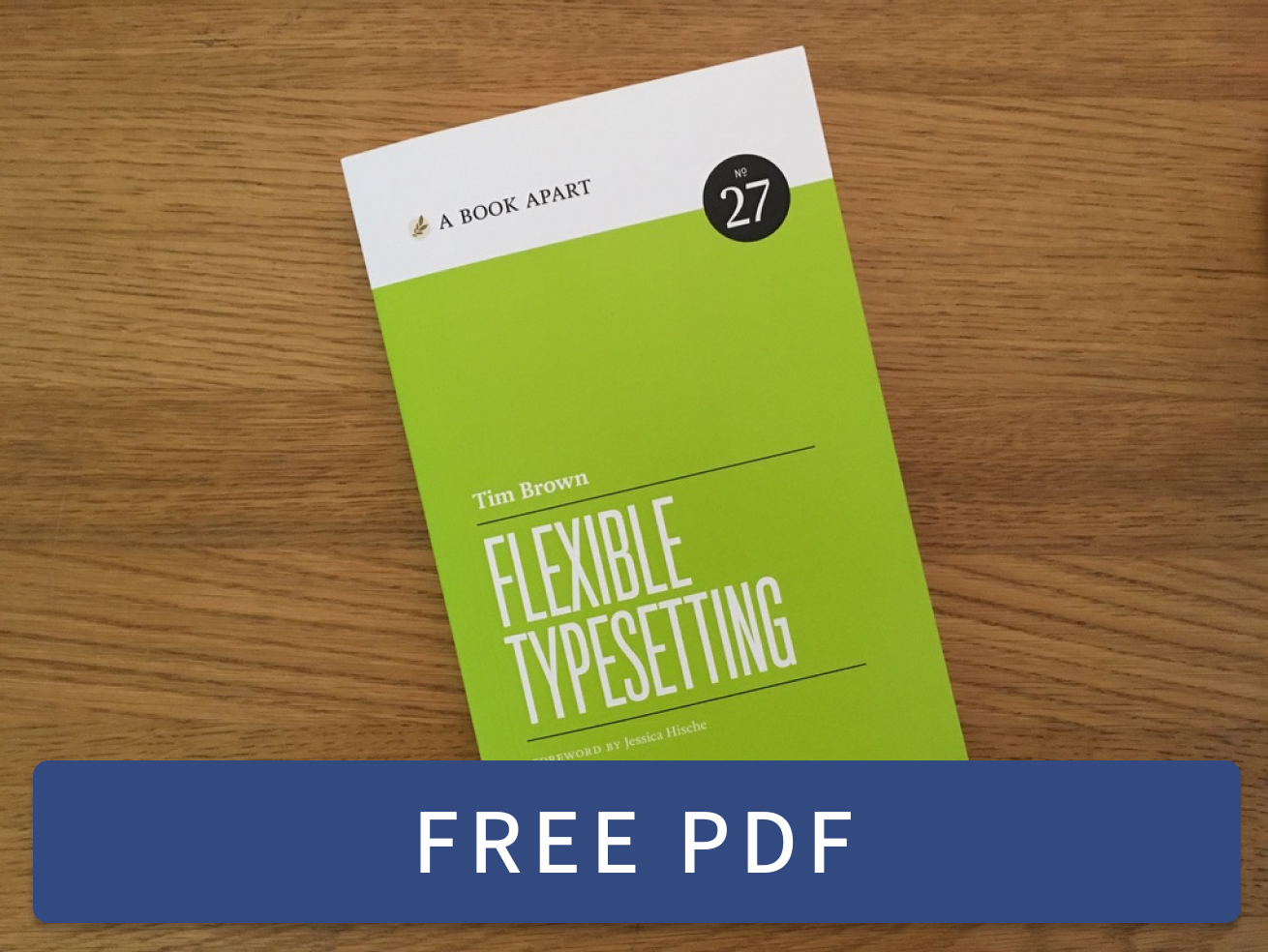National Teacher Appreciation Week 2019 deal for educators
Tue, 7 May 2019
This week, educators can get a free ebook version of Flexible Typesetting, plus an invitation to the private Slack group where readers and I share ideas about lesson plans. Send me an email describing your teaching work in two sentences, and I’ll send you a code to download the ebook at no charge.
Published in July, Flexible Typesetting is already required reading in elite design programs and has encouraged some to rethink core curriculum. Let's keep the trend going.
Thank you!
I offered this deal back in January too, and more than 100 teachers took me up on it. Learning from them has been excellent, and I'm sure I have a lot to learn from you, too.
My teachers
Finally, thanks to the teachers who continue to influence my life. From the acknowledgements of Flexible Typesetting:
Thanks to George Laws for opening my mind to the abstraction, balance, and systems in graphic design and type, for his mentoring, and for our breakfasts. Thanks to Arthur Hoener for introducing me to typography and giving me work opportunities that catalyzed my career. Thanks to Anne Galperin and Clif Meador for helping me think critically and find confidence. Thanks to Mr. Mahon for making me feel at home in art class. Thanks to the elementary school teachers who shaped and cared for me, including Mr. Weiss, Mr. Cafon, Ms. Oliver, Mr. Schmidt, and Ms. Hart.
January deal for educators
Fri, 4 Jan 2019
Teachers on my new book, Flexible Typesetting:
An outstanding text if you want to learn how to set harmonious text both on the web *and* print. 10/10
— Thomas Jockin
Students, designers, developers, and even the most seasoned typographers will gain insights into how to set type for the web and beyond.
— Amy Papaelias
Having read Tim Brown’s Flexible Typesetting ... I’m convinced I have to completely rethink my approach to intro type (at the very least).
— Maurice Meilleur
With a refreshing clarity found throughout Flexible Typesetting, Tim Brown explains what’s important in setting type for the web, but also why and how it’s important.
— Tobias Frere-Jones
Published in July, Flexible Typesetting is already required reading in elite design programs and has encouraged some to rethink core curriculum. Let's keep the trend going.
From now until the end of January, educators can get a free ebook version of Flexible Typesetting, plus an invitation to the private Slack group where readers and I share ideas about lesson plans. Send me an email describing your teaching work in two sentences, and I’ll send you a code to download the ebook at no charge.
Blogroll update
Fri, 4 Jan 2019
Adding a couple more sites to the blogroll:
Chen Hui Jing has a finger on the pulse of web design, consistently sharing interesting news and resources — with a recent focus on East Asian typography and layout. I follow HJ’s blog and Twitter feed. Looks like there’s also a bunch of good stuff on Notist.
Andy Bell is an independent web developer with a blog and all the right priorities. Andy's projects include My Browser, a tool for extracting a user's browser information (very helpful for customer support) and DevPal, a Q&A experience for web developers.
Well, that was excellent
Sat, 29 Dec 2018
Wrote this on September 3rd, then got so busy I forgot to post it:
I just returned to my desk after my first Adobe sabbatical — four weeks' time off for having worked at Adobe for five years. Along with the standard, two-week vacation time and our one-week company shutdown in July, that makes a total of seven weeks' vacation this year. The winter holidays ahead will make it eight.
What an incredible privilege it has been, and is! This amount of paid leave is life-changing. In 2018, Eileen and I took the kids on a vacation and two camping trips, we reorganized 10 years of basement clutter (making our house 50% bigger), and we spent lots of time with extended family. I also read a few books, did some cooking, and generally took my mind off work for a while.
Now that I’m back at work, I feel supercharged. The peace of mind I gained from all my time off has made me feel very focused, and my fresh eyes have made it easier to see all the moving pieces in projects. I feel unstoppable.
Whoever decided that Adobe should offer paid sabbaticals, company shutdown weeks, and other generous time-off opportunities was very smart.
As I publish this, I'm in the middle of that winter break I mentioned. The focused, unstoppable feeling I had back in September never went away. I spent the fall months learning from people all across this giant company, collaborating on strategy, and designing new typographic tools. 2019 is going to be fun.
Until then, though, I’ll continue playing Minecraft with my two older girls and reading books to my youngest — if I must! 🥰
Trying out an iOS publishing setup
Sat, 3 Nov 2018
It isn’t entirely comfortable yet, but I believe I now have a way to easily write and publish this site’s Jekyll-based posts from iOS — without writing code or actually running Jekyll. I can write in Ulysses and use the standard share feature to publish.
The key pieces are a customized version of Ryan Daigle’s iOS shortcut, the iOS app Working Copy (Ryan’s post explains how these two things work together) and Netlify, which automatically deploys my site from a GitHub repo with each commit. That’s one really nice thing about this setup — change management happens automatically.
Updating posts and working on other aspects of my site is possible on iOS too, although it’s even less comfortable: using Working Copy’s WebDAV Server feature as a remote site in Coda, I can edit easily ... but then I have to go through some motions to get the edits committed and pushed. Working Copy is a powerful app, but its Repository view does not inspire confidence. (And now that I’m done editing this post in Coda, let’s see if I can get it updated via Working Copy and live on my site...)
Frank Chimero’s ladder
Tue, 30 Oct 2018
Five minutes ago, to my embarrassment, I realized that the ladder analogy I used in Flexible Typesetting was based on Frank Chimero’s ladder analogy from The Shape of Design. Frank wrote in Chapter 1:
The creative process could be said to resemble a ladder, where the bottom rung is the blank page and the top rung the final piece. In between, the artist climbs the ladder by making a series of choices and executing them.
I wish I had realized this at some point during the three years I worked on my book, becuase I would have loved to cite Frank’s excellent book — a book that deserves an active spot on your shelf (even though it is available to read online for free). I loved The Shape of Design, and as you can see it deeply influenced me.
No doubt Frank’s work and writing will continue to inspire me, and to shape the core of my thinking so much that I will again forget it was he who catalyzed the ideas (or, simply, gave them to me).
About
Hello, I’m Tim Brown. I’m a designer and toolmaker with 15 years of product leadership experience.
My special interest is typography, a fancy word that means using fonts. I’m Head of Typography at Adobe, where I work on design tools and help people stay sharp.
I live and work in New York State’s Hudson Valley with my wife and college sweetheart Eileen, our three daughters, and our dogs.
Please feel welcome to email and connect on social.
 Flexible Typesetting
Flexible Typesetting Practicing Typography Basics
Practicing Typography Basics